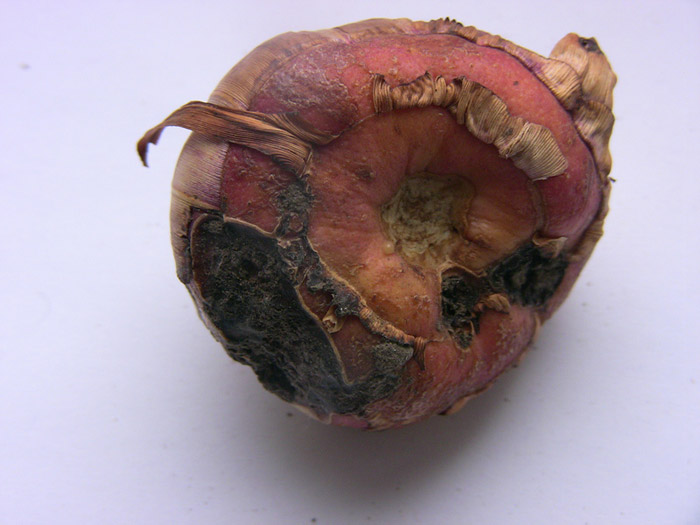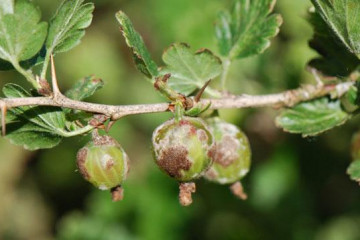Diseases of gladioli - pest control
Content:
Gladiolus is a decoration in almost every garden. There is a wide variety of colors for this flower. His homeland is Africa and Asia. The name is translated from Latin as "small sword". The article below discusses the main diseases of gladioli and how to deal with them.
Brief description of the plant
Gladiolus belongs to the Iris family. The plant is a perennial. The leaves are long and green, sharp at the tips. Their length is from 40 to 80 cm. The stem has a dense composition. The plant can reach a length of one and a half to a meter. In the upper part, up to 40 flowers are collected, which have different sizes from 5 to 15 cm. They have the shape of a funnel, and their petals are curved outward. The color of flowers can be very diverse: whitish, beige, red, etc.
Symptoms of a flower disease
There are various diseases of gladioli. In order to deal with them correctly, it is necessary, first of all, to find out the cause, based on the signs of the disease. These plants have poor immunity, so gladioli are susceptible to pests and diseases.
Yellowing of leaves
Many gardeners are wondering why the leaves of gladioli turn yellow. Various diseases are the reason for this. The affected plant does not receive enough nutrients, so it begins to deteriorate and dry out.
Twisting
Twisting of the stem is another sign that the plant is sick. Often this symptom indicates such diseases as jaundice, mosaic, ring spot.
Spotting
The presence of spots on the leaves of plants indicates the presence of an infectious disease. These diseases are dangerous because they are infectious for healthy plants.
Rust on roots
The appearance of rust on the roots is possible. Rusty spots on the leaves will help to understand this. Orange bubbles may also appear.
Other symptoms by which it is possible to understand that the plant is sick include: poor growth, brown spots appear on the roots, brown spots form on the bulbs during storage, loss of shape and sagging flowers, growths on the root system.
How to deal with dangerous diseases
There are about 30 types of diseases from which flowers wither, dry up and die.
Diseases can be bacterial or viral in nature. Below is considered why the leaves of gladioli turn yellow and what to do.
Fungal diseases
A possible reason why the leaves turn yellow in gladioli, as well as the appearance of other signs, is the infection of the plant with fungal diseases.
Bacterial scab
If the leaves of gladioli turn yellow and dry, then it is possible that it is infected with bacterial scab. This ailment is infectious. It is caused by soil bacteria. The causes of the onset of the disease:
- high humidity and insufficient acidity of the soil;
- high groundwater level;
- constantly wet weather.
Signs:
- red spots appear on the tubers and in the area near the roots, as well as ulcers and warts, which later rot;
- leaves turn yellow and withered.
If gladioli turn yellow, what to do:
- acidify alkaline soil;
- if the groundwater comes too close to the surface of the earth or the humidity is high, then drainage is required;
- highly infected plants must be destroyed. Less affected fate can be cut.
Fusarium
Also caused by soil fungi. 90% of plants die from this disease. Fungi can live in soil for up to five years. The appearance of the pathogen is associated with excessive feeding with nitrogen and organic fertilizers, excessive aridity or humidity. This disease is the reason why gladioli grow crooked and fall.
Botrythiasis
The pathogen can be spread by wind or water. The plant can become infected both during the growing season and during storage. Usually occurs in damp and cool weather. All parts of the gladiolus become affected. Small brown spots appear on the leaves. Flowers lose their shape, and spotting appears on their petals. Affected plants must be eliminated. Bulbs must be carefully sorted out before storage. Before leaving them for the winter, they must be dried, and disinfected before planting.
Septoria
It is also caused by soil fungi and is infectious. Its appearance occurs on poor and heavy soils with too high acidity. Infection usually begins in wet weather.
Symptoms:
- the appearance of red-brown spots on the leaves;
- dark watery spots appear on the tubers, which develop into black rot.
To combat this disease, it is necessary to reduce the acidity of the soil. If the damage is minor, then it is possible to remove them with a knife and grease the cut area with brilliant green.
Sclerotinosis
Infection occurs during the growing season. Fungi can live in soil for about 15-20 years. Occurs in soil with high acidity, excess humus, or if flowers are grown in damp and dark places. Also, a plant can get sick through contaminated soil. Dark spots appear on the leaves, then the foliage turns yellow, turns brown and rots. What to do if gladioli grow poorly and suffer from an ailment:
- decrease in soil acidity;
- careful selection of bulbs for storage;
- destruction of diseased plants.
Bacterial root cancer
It is an infectious disease. Fungal spores persist in the soil for about two years. It occurs due to damage to the bulbs during storage and planting, damage to the neck and the beginning of the stem during plant care. The main symptom of the disease is the appearance of various growths, which have different shapes and sizes. The bulbs must be carefully sorted out before being stored. Deformed, excessively flat with damp and dry spots must be set aside.
Viral diseases of garden gladioli
Viruses that develop inside cells are also the reason why gladioli do not bloom.
Mosaic, jaundice, spotting
These diseases are viral in nature. They have the same symptoms, and the plant can be treated with the same remedies. As a result of a virus infection, light stripes, rings and spots appear on flowers and leaves. The plant becomes smaller, and its parts change shape.The manifestation of viral diseases is associated with the defeat of insects, which are vectors. Therefore, first of all, it is necessary to fight parasites.
Main pests and control methods
Gladioli have many pests that lead to the death of the plant.
Onion mite
Mites can spread in the soil. They eat the bulbs of the plants. They penetrate there through damaged scales. The female lays many eggs, which suck all the juices from the bulb. After infection, the flower turns yellow, then dries and dies. The root itself begins to rot.
Affected flowers are eliminated. In those places where sick flowers grew, nothing can be planted for five years. Plants can be sprayed with karbofos or watered with celtan.
Medvedka
Medvedka is a parasite that is up to 3 cm long. It lives in the ground and eats the roots of the plant. Often from such parasites, the plant can dry out overnight. The insect is widespread in loose and moist soils, in which there is a large content of humus. It is possible to fight the parasite by digging the site before planting. It is worth sprinkling with dichlorvos in the pest's minks, and also adding karbophos to the soil.
Wireworm
This pest is a beetle larva. It grows up to 2 cm long. The parasite eats the bulb and makes moves in it. At low humidity, the wireworm gnaws the middle part of the shoots, from which the plant dies. The wireworm is especially common where there are thickets of wheatgrass.
The site must be kept clean by eliminating weeds. Raw potatoes, beets, or carrots can be placed near the flowers to attract the pest. Metaphos powder is embedded in the soil.
Scoops
The scoop is a small butterfly with gray or brown wings. Holes appear on the leaves of the affected plant. Insects eat leaves, stems or buds. The plant is treated with various means and herbal infusions.
Thrips
Thrips eat all varieties of gladioli. Their size is very small, up to 1.5 mm. Parasites overwinter well in bulb scales. Females lay eggs non-stop. Pests and their larvae leave blackheads.
How is it possible to treat gladioli from thrips:
- the roots are processed with karbofos after they are soaked;
- during storage, the bulbs are covered with chalk.
Slugs and caterpillars
They usually live in areas untreated from weeds. They eat leaves and buds, leaving holes. How to fight:
- set up traps for slugs;
- weed weeds;
- clean up manually.
Disease prevention and care
Gladioli spoil a variety of pests and diseases. To prevent the plant from getting sick, preventive measures and proper care are necessary.
Temperature
The bulbs are stored at 6 ° C. Before disembarking, they are transferred to a room where the temperature is 15 ° C. It is better to plant a plant when the soil has warmed up to 10 ° C. For normal growth and development, the flower needs a temperature regime in the range of 15-25 ° C.
Lighting
For planting, you need to select a well-lit place. Even a slight shade in the northern regions can delay the growth of a flower. Slight shading is acceptable in the southern regions.
Watering
During dry periods, the plant is watered every week or every 10 days. Superficially, the plant should not be watered. A bucket of water is required for 1 m². The soil should be moistened to a depth of 30-35 cm.
Spraying
In order for the plant to form buds that would delight with beautiful flowering, it must be sprayed. To do this, mix boric acid (1.5 g), copper sulfate (2 g), zinc sulfate (1 g), water (10 l), liquid soap (15 ml).
Humidity
The ideal moisture content for the growth of gladioli is about 70%.
Priming
Gladioli are not particularly demanding on the ground, so anyone will do.Where the soil is light, watering is done more often, and where it is heavy, loosening will be required.
Top dressing
If the soil is fertile and every year it is fertilized with humus, then top dressing can be skipped. If the soil is depleted, then nitrogen and potassium are added in June, nitrogen, potassium and phosphorus in July, and potassium and phosphorus in August.
Gladioli can die from many diseases and insect pests. Therefore, proper care and regular check-ups are essential. If even the slightest deviations are noticed, the entrepreneur must immediately take rescue measures, otherwise it will not be possible to save the flower later.



















